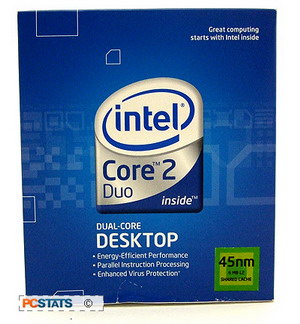 The Intel Core 2
Duo E8500, with its 3.16GHz clock speed, 1333MHz FSB speed and 6MB of L2 cache,
remains a force to be reckoned with. In real-world office applications the E8500
was generally a little faster than the Phenom II X4 955 and a little slower than
the Core i7 920. All processors are absolutely fast enough for average desktop
applications likely to be encountered in the office or at home. The same holds
true during gaming, where the majority of titles are more suited to
high-frequency dual-core processors rather than parallel quad-core processors.
The Intel Core 2
Duo E8500, with its 3.16GHz clock speed, 1333MHz FSB speed and 6MB of L2 cache,
remains a force to be reckoned with. In real-world office applications the E8500
was generally a little faster than the Phenom II X4 955 and a little slower than
the Core i7 920. All processors are absolutely fast enough for average desktop
applications likely to be encountered in the office or at home. The same holds
true during gaming, where the majority of titles are more suited to
high-frequency dual-core processors rather than parallel quad-core processors.
In the case of the Intel Core 2 duo E8400 vs. the Intel Core
2 Duo E8500, the result is as expected, an incremental step forward in terms of
performance.
This is one of those situations where there's really
only one variable that changes, the overall multiplier/clockspeed of the
processor.
So all that's left is the E8500's 3.16GHz clockspeed
versus the E8400's 3.0GHz clock speed. In Sysmark, perhaps the most accurate
benchmark of real-world applications, that extra speed put the E8500 at the top
of the overall rankings. The E8500 comes in ahead of quad-core processors like
the Core i7 920 and the Phenom II X4 955.
 Of course, spending
$230 CDN ($200 USD, £130 GBP), on a
dual-core processor is pushing things dangerously close to the price of
quad-core processors. For those who are looking at content creation applications
in the fields of 3D rendering and video encoding, that extra money would be
better spent on more cores instead of faster ones.
Of course, spending
$230 CDN ($200 USD, £130 GBP), on a
dual-core processor is pushing things dangerously close to the price of
quad-core processors. For those who are looking at content creation applications
in the fields of 3D rendering and video encoding, that extra money would be
better spent on more cores instead of faster ones.
The other group that will find this an easy decision are
the overclockers. The best overclocking is generally accomplished on processors
with the highest multipliers, so the Core 2 Duo E8500's 9.5x multiplier makes
for some very good overclocking indeed. Moving from 3.16GHz up to 4.24GHz makes
the Core 2 Duo E8500 an unrivaled competitor.
Like the Core 2 Duo E8400, the Intel Core 2 Duo E8500
processor is handicapped against triple and quad-core processors in tests that
are multi-threaded. In standard desktop applications that people use everyday,
like Word or email, surfing the web or doing spreadsheets, the Core 2 Duo E8500
is more than powerful. The real question you'll have to ask yourself is whether
the marginal added cost is worth shaving off a few seconds of processing time.
In most cases the increase in price is greater than the increase in performance,
which makes it difficult to give the Core 2 Duo E8500 a full recommendation when
its sibling, the E8400, is so readily available.
Find out about this and many other reviews by joining the Weekly PCstats.com Newsletter today!
Catch all of PCSTATS latest reviews right here.
Related Articles
Here are a few other articles that you
might enjoy as well...
- Intel
Core 2 Duo E8500 3.16GHz 1333MHz FSB Processor Review
- Intel
Core 2 Duo E8400 3.0GHz 1333MHz FSB Processor Review
- AMD
Phenom II X4 955 Black Edition 3.2 GHz Socket AM3 Processor Review
- Intel
32nm Westmere Processor Roadmap - Integrated Graphics CPU
- Intel
Core 2 Duo E6750 2.66 GHz 1333MHz FSB Processor
Review
